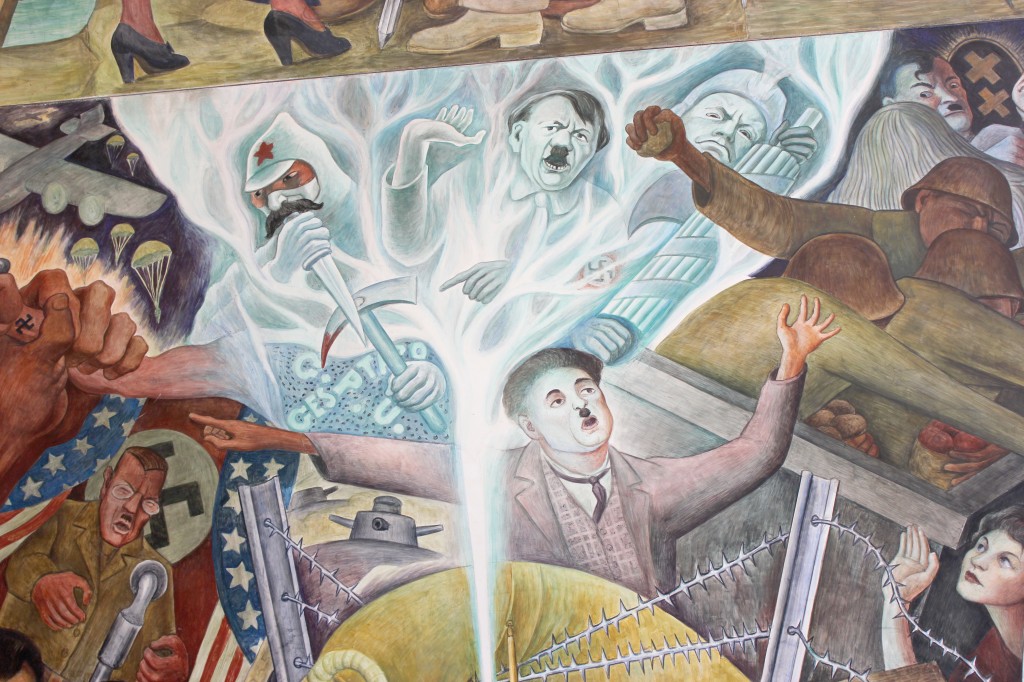Diego Rivera’s mural on display but out of view

By Peter Hernandez
The Guardsman
Getting a peek at one of the most important San Franciscan murals of the 20th century may soon become more difficult.
Tucked behind the Creative Arts building at City College’s Ocean campus, the Pan American Unity mural by Mexican artist Diego Rivera has been off limits after hours for viewing it were significantly reduced over the summer.
Completed during World War II, it’s Rivera’s largest contiguous mural.
The mural was open just 16 hours per week over the five-week session, down from 20 during last year’s summer session. In part due to the shorter session, the mural was available for viewing only 80 hours in total this year compared to 180 last year.
“It should be available to the public at least six days of the week,” said Halé Guerra, Senior Management Coordinator of the Liberal Arts Department.
Will Maynez, former physics instructor and unofficial guardian of the mural, envisions a permanent venue for the mural — The Center for Pan American Unity — to coincide with the planned erection of the Performing Arts Center, which is slated to break ground next month.
The mural, which is displayed in the Diego Rivera Theater, has seen a long history of events that have further displaced it from its originally intended home — a grand library in place of Cloud Hall on the Ocean Campus that never came to be due to the death of its renowned architect, Timothy Pfleuger, who was Director of Architecture at City College in the 1940’s.
Its history suggests a long series of misfortunes: it was stored and displaced for 21 years before finding its present home and it was planned to be expanded three times its size and political conflicts with Rivera’s affiliation as a Communist in the midst of the Red Scare in the 1940’s further delayed giving the mural a permanent home.
Lack of a budget and meager grants are leaving docents paid too little and working largely out of a dedication to the mural.
The mural’s two docents were paid $350 each for their work over the summer session, which equates to being paid around $9 per hour using a grant sought by the dean of Liberal Arts, Ms. Bob Davis.
The steadily decreasing financial means for the mural’s stability has resulted in an influx of community members who, out of dedication, provide their consultation as a resource for Maynez’s aspirations for the mural, through legal, artistic and architectural assistance.
With the communities assistance, Maynez aspires to create a Center for Pan American Unity that would be adjacent to the planned Performing Arts Center, which is in limbo during the City College fiscal crisis, and would be constructed behind Riordan High School on Phelan Avenue.
The mural’s scale is disproportionate to the hallway of the Diego Rivera Theater, Maynez said. Themes of dualities, like science against indigenous culture, are obstructed by distance between the viewer and the mural. If it were in a larger venue, where viewers could step further back to take in the entire piece, its full picture and its themes would be asserted more clearly, he said.
The mural was created at the height of WWII during Diego Rivera’s last visit to San Francisco. After its public inception on Treasure Island, it was crated in boxes and stored for two decades, silently awaiting its excavation.
Rivera died of cancer in 1957 and Timothy Pfleuger, who commissioned the work for the library he was designing for City College, suddenly died in the street of heart attack in 1946.
Pfleuger’s son, Timothy Pfleuger, accommodated the mural in his auditorium in 1961, which is now named the Diego Rivera Theater, where it awaits new viewers and a new home.

Comments are closed.